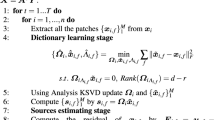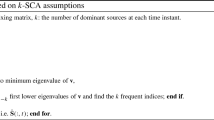Abstract
This paper is concerned with overcomplete blind source separation using a two-stage sparse representation method. An algorithm incorporating generalized Gaussian function and smoothed \(l_0 \) norm (GGFSL0), which can be viewed as the extension of smoothed \(l_0 \) norm (SL0), is proposed. Compared with previous methods, GGFSL0 tries to directly minimize the \(l_0 \) norm instead of minimizing the \(l_1 \) norm. Numerical experiments with different parameters, sparsity, noise, and dimension demonstrate the effectiveness of proposed algorithm.







Similar content being viewed by others
References
L. Albera, A. Ferréol, P. Comon, P. Chevalier, Blind identification of overcomplete mixtures of sources (BIOME). Linear Algebra Its Appl. 391, 3–30 (2004)
P. Bofill, M. Zibulevsky, Underdetermined blind source separation using sparse representations. Signal Process. 81(11), 2353–2362 (2001)
E. Candès, J. Romberg, \(l^1\)-Magic: recovery of sparse signal via convex programming. (2005). http://citeseerx.ist.psu.edu/viewdoc/download?doi=10.1.1.212.9120&rep=rep1&type=pdf
D.J. Candès, T. Tao, Decoding by linear programming. IEEE Trans. Inf. Theory 51(12), 4203–4215 (2005)
P. Common, C. Jutten, Handbook of Blind Source Separation: Independent Component Analysis and Applications (Elsevier, Oxford, 2010)
M. Davies, N. Mitianoudis, Simple mixture model for sparse overcomplete ICA. IEEE Proc. Vis. Image Signal Process. 151(1), 35–43 (2004)
D.L. Donoho, For most large underdetermined systems of linear equations the minimal \(l_1 \) norm solution is also the sparsest solution. Commun. Pure Appl. Math. 59(6), 797–829 (2006)
D.L. Donoho, M. Elad, V. Temlyakov, Stable recovery of sparse overcomplete representations in the presence of noise. IEEE Trans. Inf. Theory 52(1), 6–18 (2006)
P.G. Georgiev, F. Theis, A. Cichocki, Sparse component analysis and blind source separation of underdetermined mixtures. IEEE Trans. Neural Netw. 16(4), 992–996 (2005)
I.F. Gorodnitsky, B.D. Rao, Sparse signal reconstruction from limited data using FOCUSS, a re-weighted minimum norm algorithm. IEEE Trans. Signal Process. 45(3), 600–616 (1997)
R. Gribonval, S. Lesage, A survey of sparse component analysis for blind source separation: Principles, perspectives, and new challenges. in Proceeding European Symposium on Artificial Neural Networks (ESANN), (Belgium, 2006), pp. 323–330.
Z. He, A. Cichocki, Y. Li, S. Xie, S. Sanei, K-hyperline clustering learning for sparse component analysis. Signal Process. 89(6), 1011–1022 (2009)
S.G. Kim, Underdetermind blind source separation based on subspace representation. IEEE Trans. Signal Process. 57(7), 2604–2614 (2009)
Y.Q. Li, A. Cichocki, S. Amari, Analysis of sparse representation and blind source separation. Neural Comput. 6(6), 1193–1234 (2004)
H. Mohimani, M. Babaie-Zadeh, C. Jutten, A fast approach for overcomplete sparse decomposition based on smoothed \(l_0 \) norm. IEEE Trans. Signal Process. 57(1), 289–301 (2009)
G.R. Naik, D.K. Kumar, Determining number of independent sources in undercomplete mixture. EURASIP J. Adv. Signal Process. 2009, 1–5 (2009)
G.R. Naik, D.K. Kumar, An overview of independent component analysis and its applications. Inf. Int. J. Comput. Inf. 35(1), 63–81 (2011)
G.R. Naik, D.K. Kumar, Dimensional reduction using blind source separation for identifying sources. Int. J. Innov. Comput. Inf. Control 7(2), 989–1000 (2011)
B. Prasad, H. Saruwatari, K. Shikano, Estimation of shape parameter of GGD function by negentropy matching. Neural Process. Lett. 22(3), 377–389 (2005)
V.G. Reju, S.N. Koh, I.Y. Soon, An algorithm for mixing matrix estimation in instantaneous blind source separation. Signal Process. 89(9), 1762–1773 (2009)
J.J. Thiagarajan, K.N. Ramamurthy, A. Spanias, Mixing matrix estimation using discriminative clustering for blind source separation. Digital Signal Process. 23(1), 9–18 (2013)
S.L. Xie, L. Yang, J.M. Yang et al., Time-frequency approach to underdetermined blind source separation. IEEE Trans. Neural Netw. Learn. Syst. 23(2), 306–316 (2012)
G.M. Zhang, Z.M. Cui, J.M. Chen, J. Wu, CT image de-noising model based on independent component analysis and curvelet transform. J. Softw. 5(9), 1006–1013 (2010)
Acknowledgments
The authors would like to thank the anonymous reviewers and the editors for their valuable comments and suggestions. This work is supported by Natural Science Foundation of China (No. 61102103), Youth Foundation of Naval University of Engineering (No. HGDQNJJ13005), Natural Science Foundation of Hubei Province (No. 2013CFB414) and the Special Fund for Basic Scientific Research of Central Colleges, China University of Geosciences Wuhan (No. CUGL130247).
Author information
Authors and Affiliations
Corresponding author
Rights and permissions
About this article
Cite this article
Qi, R., Zhang, Y. & Li, H. Overcomplete Blind Source Separation Based on Generalized Gaussian Function and SL0 Norm. Circuits Syst Signal Process 34, 2255–2270 (2015). https://doi.org/10.1007/s00034-014-9952-9
Received:
Revised:
Accepted:
Published:
Issue Date:
DOI: https://doi.org/10.1007/s00034-014-9952-9




